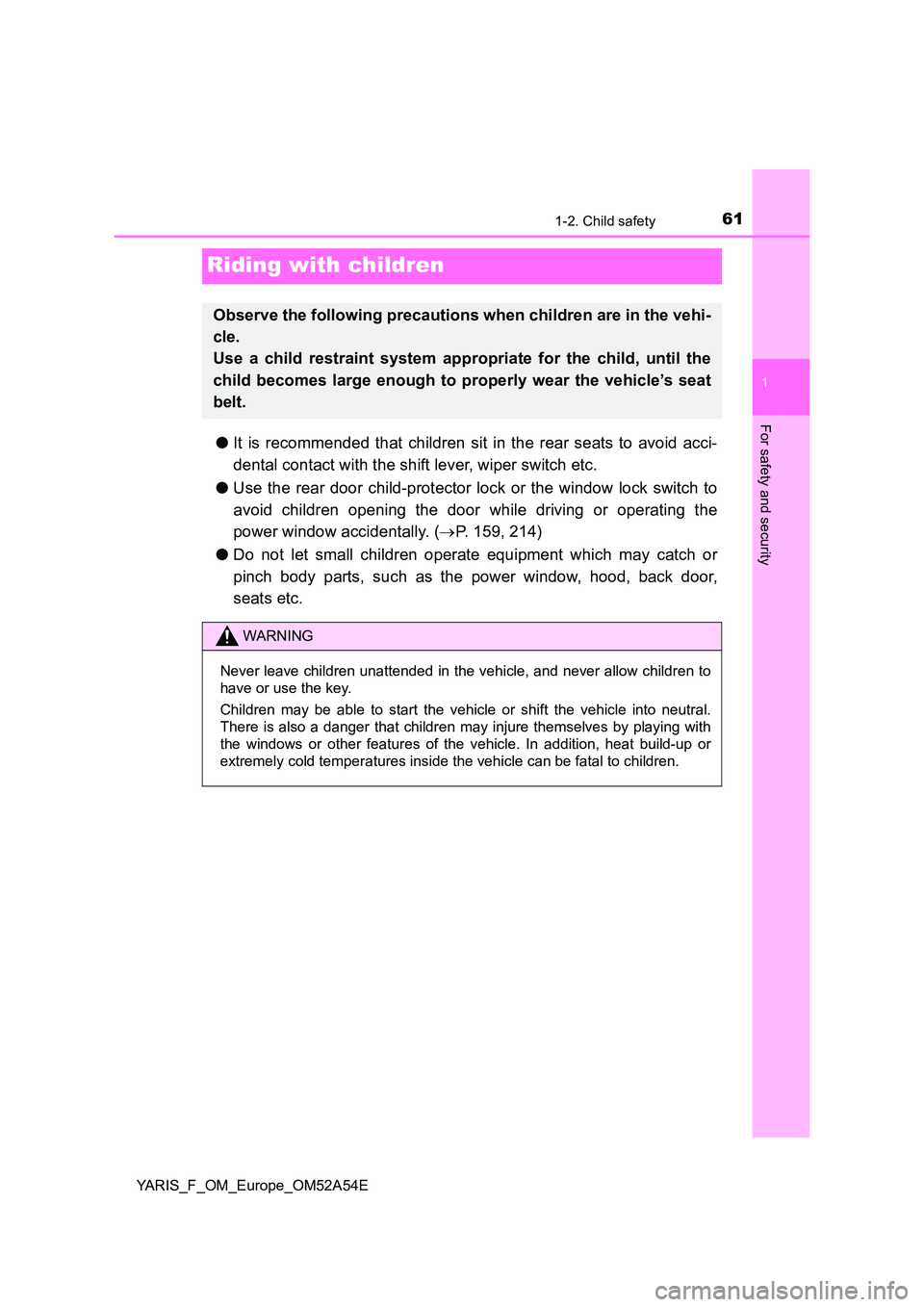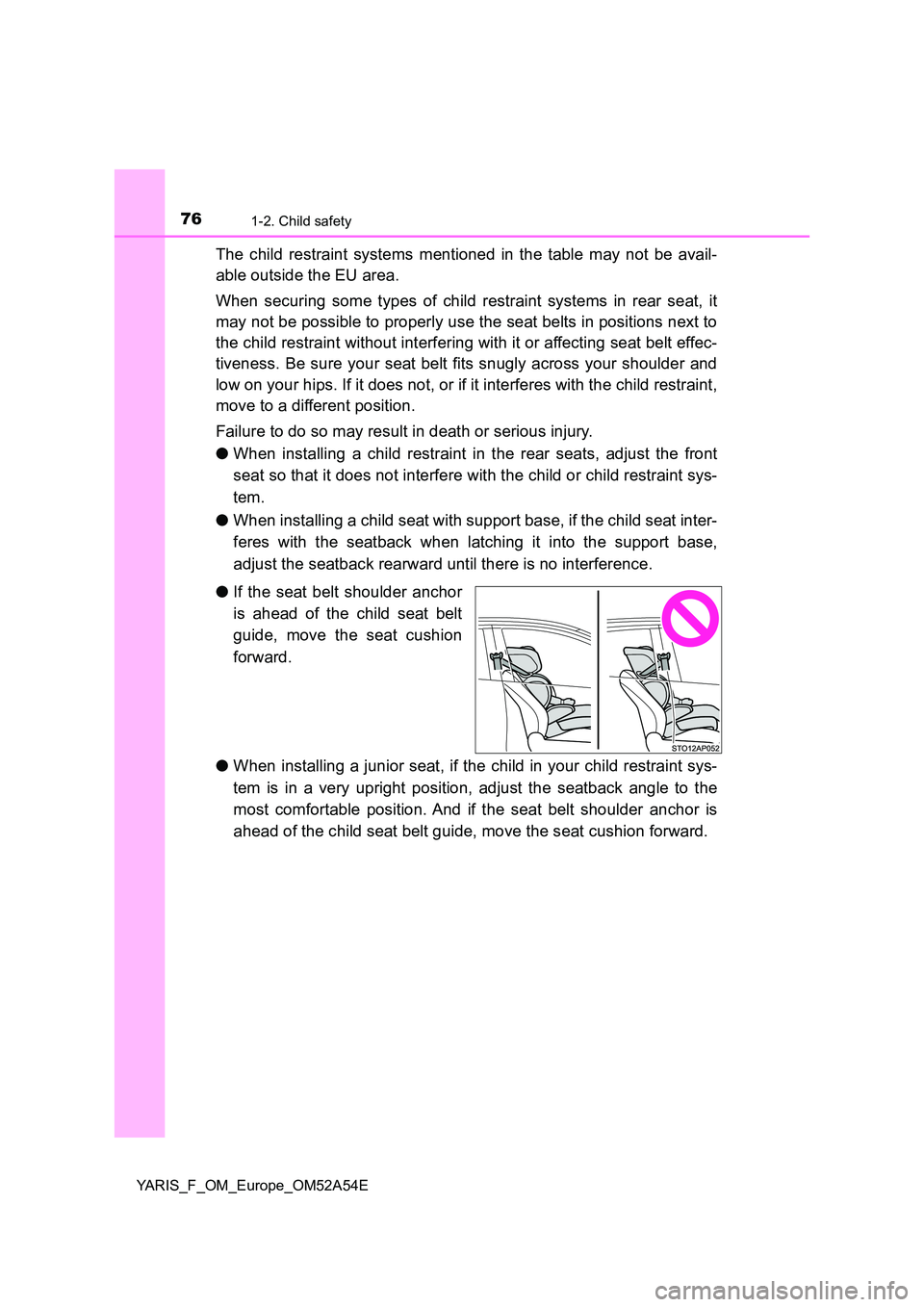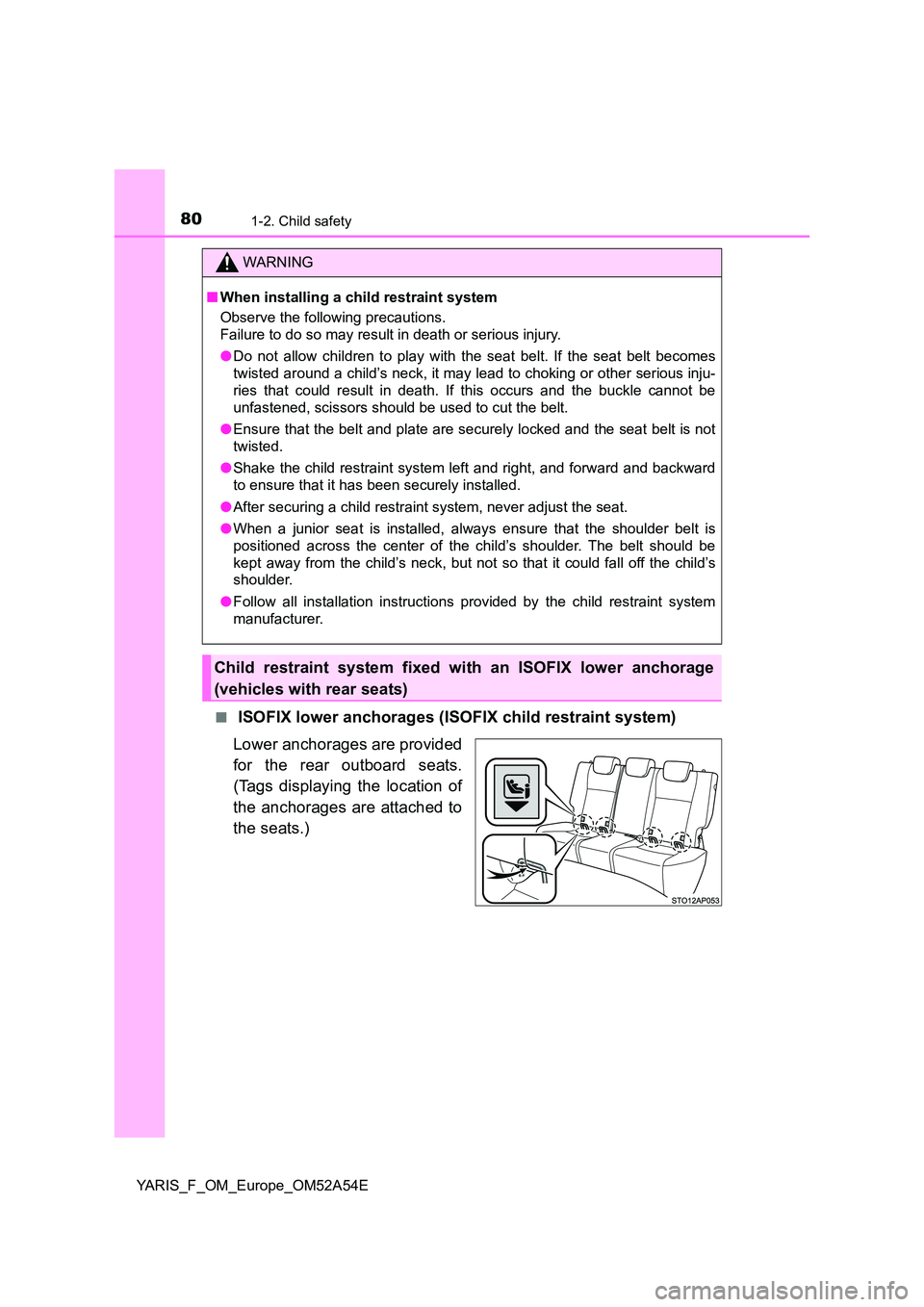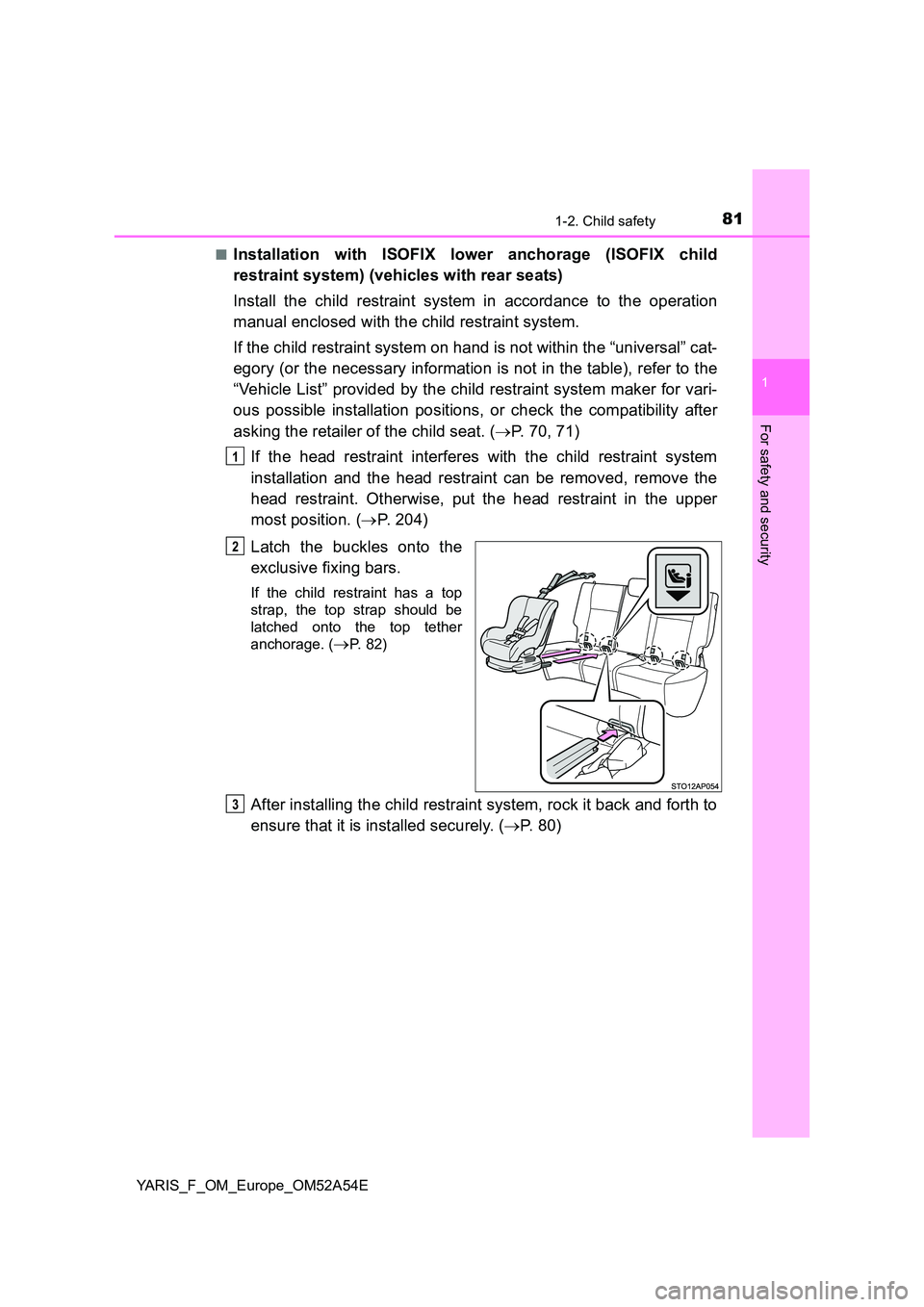Page 48 of 692

481-1. For safe use
YARIS_F_OM_Europe_OM52A54E
WARNING
■SRS airbag precautions
● The SRS front passenger airbag also deploys with considerable force, and
can cause death or serious injury especially if the front passenger is very
close to the airbag. The front passenger seat should be as far from the
airbag as possible with the seatback adjusted, so the front passenger sits
upright.
● Improperly seated and/or restrained infants and children can be killed or
seriously injured by a deploying airbag. An infant or child who is too small
to use a seat belt should be properly secured using a child restraint sys-
tem. Toyota strongly recommends that all infants and children be placed in
the rear seats of the vehicle and proper ly restrained. The rear seats are
safer for infants and children than the front passenger seat. ( P. 62)
●Do not sit on the edge of the seat or
lean against the dashboard.
● Do not allow a child to stand in front of
the SRS front passenger airbag unit or
sit on the knees of a front passenger.
● Do not allow the front seat occupants to
hold items on their knees.
Page 51 of 692

511-1. For safe use
1
For safety and security
YARIS_F_OM_Europe_OM52A54E
WARNING
■SRS airbag precautions
● Do not strike or apply significant levels of force to the area of the SRS
airbag components.
Doing so can cause the SRS airbags to malfunction.
● Do not touch any of the component parts immediately after the SRS
airbags have deployed (inflated) as they may be hot.
● If breathing becomes difficult after the SRS airbags have deployed, open a
door or window to allow fresh air in, or leave the vehicle if it is safe to do
so. Wash off any residue as soon as possible to prevent skin irritation.
● Vehicles without SRS curtain shield airbags: If the areas where the SRS
airbags are stored, such as the steering wheel pad, are damaged or
cracked, have them replaced by any authorized Toyota retailer or Toyota
authorized repairer, or any reliable repairer.
● Vehicles with SRS curtain shield airbags: If the areas where the SRS
airbags are stored, such as the steering wheel pad and front and rear pillar
garnishes, are damaged or cracked, have them replaced by any autho-
rized Toyota retailer or Toyota authorized repairer, or any reliable repairer.
■ Modification and disposal of SRS airbag system components
Do not dispose of your vehicle or perform any of the following modifications
without consulting any authorized Toyota retailer or Toyota authorized
repairer, or any reliable repairer. The SRS airbags may malfunction or
deploy (inflate) accidentally, causing death or serious injury.
● Installation, removal, disassembly and repair of the SRS airbags
● Repairs, modifications, removal or replacement of the steering wheel,
instrument panel, dashboard, seats or seat upholstery, front, side and rear
pillars or roof side rails
● Repairs or modifications of the front fender, front bumper, or side of the
occupant compartment
● Installation of a grille guard (bull bars, kangaroo bar, etc.), snow plows,
winches
● Modifications to the vehicle’s suspension system
● Installation of electronic devices such as mobile two-way radios (RF-trans-
mitter) and CD players
Page 52 of 692

521-1. For safe use
YARIS_F_OM_Europe_OM52A54E
■If the SRS airbags deploy (inflate)
● Slight abrasions, burns, bruising, etc., may be sustained from SRS airbags,
due to the extremely high speed deployment (inflation) by hot gases.
● A loud noise and white powder will be emitted.
● Vehicles without SRS curtain shield airbags: Parts of the airbag module
(steering wheel hub, airbag cover and inflator) as well as the front seats may
be hot for several minutes. The airbag itself may also be hot.
● Vehicles with SRS curtain shield airbags: Parts of the airbag module (steer-
ing wheel hub, airbag cover and inflator) as well as the front seats, parts of
the front and rear pillars, and roof side rails, may be hot for several minutes.
The airbag itself may also be hot.
● The windshield may crack.
■ SRS airbag deployment conditions (SRS front airbags)
● The SRS front airbags will deploy in the event of an impact that exceeds
the set threshold level (the level of force corresponding to an approximately
20 - 30 km/h [12 - 18 mph] frontal collision with a fixed wall that does not
move or deform).
However, this threshold velocity will be considerably higher in the following
situations:
• If the vehicle strikes an object, such as a parked vehicle or sign pole,
which can move or deform on impact
• If the vehicle is involved in an underride collision, such as a collision in
which the front of the vehicle “underrides”, or goes under, the bed of a
truck
● Depending on the type of collision, it is possible that only the seat belt pre-
tensioners will activate.
■ SRS airbag deployment conditions (SRS side airbags and SRS curtain
shield airbags [if equipped])
● The SRS side airbags and SRS curtain shield airbags will deploy in the
event of an impact that exceeds the set threshold level (the level of force
corresponding to the impact force produced by an approximately 1500 kg
[3300 lb.] vehicle colliding with the vehicle cabin from a direction perpendic-
ular to the vehicle orientation at an approximate speed of 20 - 30 km/h
[12 - 18 mph]).
● The SRS curtain shield airbags may also deploy in the event of a severe
frontal collision.
Page 56 of 692
561-1. For safe use
YARIS_F_OM_Europe_OM52A54E
● The surface of the seats with the side
airbag is scratched, cracked, or other-
wise damaged.
● Vehicles with SRS curtain shield
airbags: The portion of the front pillars,
rear pillars or roof side rail garnishes
(padding) containing the curtain shield
airbags inside is scratched, cracked, or
otherwise damaged.
Page 61 of 692

611-2. Child safety
1
For safety and security
YARIS_F_OM_Europe_OM52A54E
Riding with children
●It is recommended that children sit in the rear seats to avoid acci-
dental contact with the shift lever, wiper switch etc.
● Use the rear door child-protector lock or the window lock switch to
avoid children opening the door while driving or operating the
power window accidentally. ( P. 159, 214)
● Do not let small children operate equipment which may catch or
pinch body parts, such as the power window, hood, back door,
seats etc.
Observe the following precautions when children are in the vehi-
cle.
Use a child restraint system appropriate for the child, until the
child becomes large enough to properly wear the vehicle’s seat
belt.
WARNING
Never leave children unattended in the vehicle, and never allow children to
have or use the key.
Children may be able to start the vehicle or shift the vehicle into neutral.
There is also a danger that children may injure themselves by playing with
the windows or other features of the vehicle. In addition, heat build-up or
extremely cold temperatures inside the vehicle can be fatal to children.
Page 76 of 692

761-2. Child safety
YARIS_F_OM_Europe_OM52A54E
The child restraint systems mentioned in the table may not be avail-
able outside the EU area.
When securing some types of child restraint systems in rear seat, it
may not be possible to properly use the seat belts in positions next to
the child restraint without interfering with it or affecting seat belt effec-
tiveness. Be sure your seat belt fits snugly across your shoulder and
low on your hips. If it does not, or if it interferes with the child restraint,
move to a different position.
Failure to do so may result in death or serious injury.
● When installing a child restraint in the rear seats, adjust the front
seat so that it does not interfere with the child or child restraint sys-
tem.
● When installing a child seat with support base, if the child seat inter-
feres with the seatback when latching it into the support base,
adjust the seatback rearward until there is no interference.
● If the seat belt shoulder anchor
is ahead of the child seat belt
guide, move the seat cushion
forward.
● When installing a junior seat, if the child in your child restraint sys-
tem is in a very upright position, adjust the seatback angle to the
most comfortable position. And if the seat belt shoulder anchor is
ahead of the child seat belt guide, move the seat cushion forward.
Page 80 of 692

801-2. Child safety
YARIS_F_OM_Europe_OM52A54E
■ ISOFIX lower anchorages (ISOFIX child restraint system)
Lower anchorages are provided
for the rear outboard seats.
(Tags displaying the location of
the anchorages are attached to
the seats.)
WARNING
■ When installing a child restraint system
Observe the following precautions.
Failure to do so may result in death or serious injury.
● Do not allow children to play with the seat belt. If the seat belt becomes
twisted around a child’s neck, it may lead to choking or other serious inju-
ries that could result in death. If this occurs and the buckle cannot be
unfastened, scissors should be used to cut the belt.
● Ensure that the belt and plate are securely locked and the seat belt is not
twisted.
● Shake the child restraint system left and right, and forward and backward
to ensure that it has been securely installed.
● After securing a child restraint system, never adjust the seat.
● When a junior seat is installed, always ensure that the shoulder belt is
positioned across the center of the child’s shoulder. The belt should be
kept away from the child’s neck, but not so that it could fall off the child’s
shoulder.
● Follow all installation instructions provided by the child restraint system
manufacturer.
Child restraint system fixed with an ISOFIX lower anchorage
(vehicles with rear seats)
Page 81 of 692

811-2. Child safety
1
For safety and security
YARIS_F_OM_Europe_OM52A54E
■Installation with ISOFIX lower anchorage (ISOFIX child
restraint system) (vehicles with rear seats)
Install the child restraint system in accordance to the operation
manual enclosed with the child restraint system.
If the child restraint system on hand is not within the “universal” cat-
egory (or the necessary information is not in the table), refer to the
“Vehicle List” provided by the child restraint system maker for vari-
ous possible installation positions, or check the compatibility after
asking the retailer of the child seat. ( P. 70, 71)
If the head restraint interferes with the child restraint system
installation and the head restraint can be removed, remove the
head restraint. Otherwise, put the head restraint in the upper
most position. ( P. 204)
Latch the buckles onto the
exclusive fixing bars.
If the child restraint has a top
strap, the top strap should be
latched onto the top tether
anchorage. (P. 82)
After installing the child restraint system, rock it back and forth to
ensure that it is installed securely. ( P. 8 0 )
1
2
3